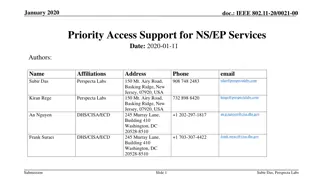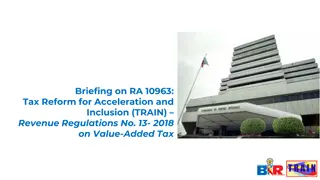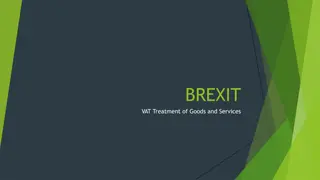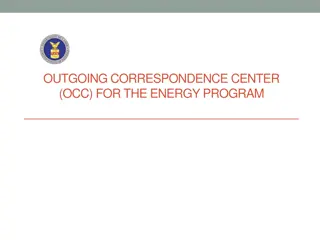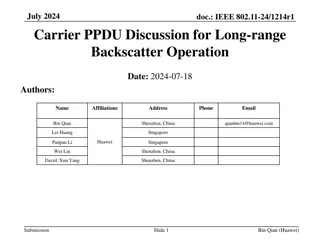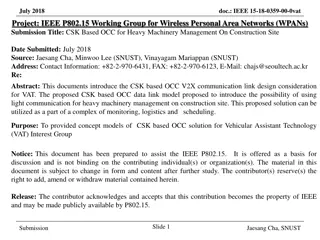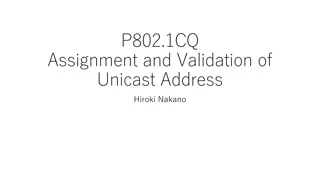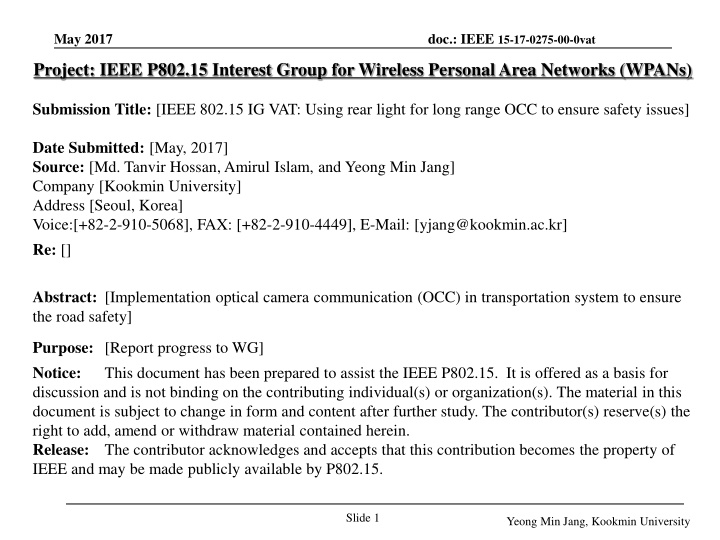
Using Rear Light for Long Range Optical Camera Communication (OCC) for Road Safety
Implementation of optical camera communication (OCC) in transportation systems to enhance road safety, focusing on protecting individuals using roads and vehicles. The document discusses advanced driver assistance systems (ADAS), key technologies for autonomous vehicles, and control elements in various driving scenarios for ensuring safety. It emphasizes the importance of enabling drivers to easily override system actions and taking actions to mitigate crash severity in critical situations.
Download Presentation

Please find below an Image/Link to download the presentation.
The content on the website is provided AS IS for your information and personal use only. It may not be sold, licensed, or shared on other websites without obtaining consent from the author. If you encounter any issues during the download, it is possible that the publisher has removed the file from their server.
You are allowed to download the files provided on this website for personal or commercial use, subject to the condition that they are used lawfully. All files are the property of their respective owners.
The content on the website is provided AS IS for your information and personal use only. It may not be sold, licensed, or shared on other websites without obtaining consent from the author.
E N D
Presentation Transcript
May 2017 doc.: IEEE 15-17-0275-00-0vat Project: IEEE P802.15 Interest Group for Wireless Personal Area Networks (WPANs) Submission Title: [IEEE 802.15 IG VAT: Using rear light for long range OCC to ensure safety issues] Date Submitted: [May, 2017] Source: [Md. Tanvir Hossan, Amirul Islam, and Yeong Min Jang] Company [Kookmin University] Address [Seoul, Korea] Voice:[+82-2-910-5068], FAX: [+82-2-910-4449], E-Mail: [yjang@kookmin.ac.kr] Re: [] Abstract: [Implementation optical camera communication (OCC) in transportation system to ensure the road safety] Purpose: [Report progress to WG] Notice: This document has been prepared to assist the IEEE P802.15. It is offered as a basis for discussion and is not binding on the contributing individual(s) or organization(s). The material in this document is subject to change in form and content after further study. The contributor(s) reserve(s) the right to add, amend or withdraw material contained herein. Release: The contributor acknowledges and accepts that this contribution becomes the property of IEEE and may be made publicly available by P802.15. Slide 1 Yeong Min Jang, Kookmin University
January 2017 doc.: IEEE 15-17-0275-00-0vat IEEE 802.15 IG VAT Using rear light for long range OCC to ensure safety issues Slide 2 Yeong Min Jang, Kookmin University
May 2017 doc.: IEEE 15-17-0275-00-0vat Introduction Road safety is primarily meant about the protection and security of all those who travel on roads by foot or using vehicle. Currently advanced driver assistance system (ADAS) helps the driver in the diving process and enables safe, relaxed driving. It is designed to increase vehicle safety more generally road safety Slide 3 Yeong Min Jang, Kookmin University
May 2017 Advanced Driver Assistance Systems Systems & subsystems on the way to fully automated highway system Automated Vehicle Guidance doc.: IEEE 15-17-0275-00-0vat Slide 4 Yeong Min Jang, Kookmin University
May 2017 doc.: IEEE 15-17-0275-00-0vat Sub-sections of ADAS Slide 5 Yeong Min Jang, Kookmin University
May 2017 doc.: IEEE 15-17-0275-00-0vat Key Technologies for Autonomous Vehicles There are existing key technologies enabling autonomous cars Slide 6 Yeong Min Jang, Kookmin University
May 2017 doc.: IEEE 15-17-0275-00-0vat Principles: Control Elements Normal Driving Situations The driver should be able to easily and quickly override system actions at any time under normal driving situations and when crashes are avoidable Critical Driving Situations When the crash is determined to be unavoidable, the system can take actions to try to mitigate the crash severity When a loss of control is determined to be unavoidable, the system can take actions to try to regain stability and control When it determines that driver performance is impaired, the system can take actions to avoid or mitigate collisions Slide 7 Yeong Min Jang, Kookmin University
May 2017 doc.: IEEE 15-17-0275-00-0vat Principles: Operation Elements For systems that control the vehicle under normal driving situations, the driver should have a means to turn it OFF manually and to keep the system in the OFF state Drivers should be informed of the conditions that result in system activation and deactivation Drivers should be informed of the conditions when system operation is different or is not guaranteed Slide 8 Yeong Min Jang, Kookmin University
May 2017 Difference between RADAR & LiDAR doc.: IEEE 15-17-0275-00-0vat RADAR LiDAR Abbreviation Radio detection and ranging Light detection and ranging The Transmitter of a radar system sends a radio (or microwave) pulse into the air, an d part of this pulse is reflected by the obje cts. Transmission and reception of a laser signal to determine the time duration System The time duration from transmission to re ception of the signal is used to calculate t he range (or distance), and the angle of re flected waves gives the altitude of the obj ect. Additionally the speed of the object is calculated using the Doppler Effect. With the time duration and the speed of light in the medium, an accurate di stance to the point of observation can be taken. Operational principal LASER, Scanner and Optics, Photo detector and Receiver electronics, an d Position and Navigation systems transmitter, wave guide, receiver, duplexe r Component 3d scanning (agriculture, biology, arc haeology, geomatics, geography, geo logy, geomorphology, seismology, fo restry, remote sensing, and atmosphe ric physics.) Military, marine, meteorologists, geologis ts, Application Slide 9 Yeong Min Jang, Kookmin University
May 2017 OCC based vehicle-to-infrastructure (V2X) (1/3) doc.: IEEE 15-17-0275-00-0vat Negligible multipath fading and Doppler effects Static channel impulse response compared with optical signal frequency Minimum interference Spatial separation of multiple light source in receiving plane Simpler OCC link design than Radio Frequency (RF) channel Due negligible multipath fading and Doppler effect Simultaneous data communication without complicated protocol Spatial separation of multiple light source in receiving plane Each pixel acts as independent receiver Slide 10 Yeong Min Jang, Kookmin University
May 2017 doc.: IEEE 15-17-0275-00-0vat OCC based V2X (2/3) Background noise from sun Pixel could saturate due to high back ground noise from sun Hence unable to receive signal Only Line of Sight (LoS) communication is possible for V2V communication Camera frame rates vs. vehicle speed Unable to receive data at time interval between two frames For low frame rate camera, vehicle will travel more distance at that interval Hence increase tracking complexity Also increase collision probability Perspective distortion Due to viewing angle and distance Data from multiple LED may not be resolved Slide 11 Yeong Min Jang, Kookmin University
May 2017 doc.: IEEE 15-17-0275-00-0vat OCC based V2X (3/3) Advantages MIMO OCC Each pixel is an independent PD, and the sampling frequency (i.e. fcamera) is limited to <100 Hz for standard cameras PD-based receiver cannot be used to separate the mixed signal. This is because a PD capture the sum of all light (i.e. intensity) and it cannot distinguish lights coming from different directions. Imaging MIMO can be used to increase data rates, and to offer multiple access, as well as reducing the bit error rate (BER). MIMO can improve received signal-to-noise ratio (SNR). Slide 12 Yeong Min Jang, Kookmin University
May 2017 doc.: IEEE 15-17-0275-00-0vat Conclusion Automation should provide users with safe, comfortable, convenient and efficient mobility On that platform ADAS is coming in front us Long range OCC may provide proper solution for the ADAS system to make more safe and reliable When the advanced driver assistance systems control or support elements of the driving task, drivers should be fully aware of the performance and limitations of those functions Slide 13 Yeong Min Jang, Kookmin University




